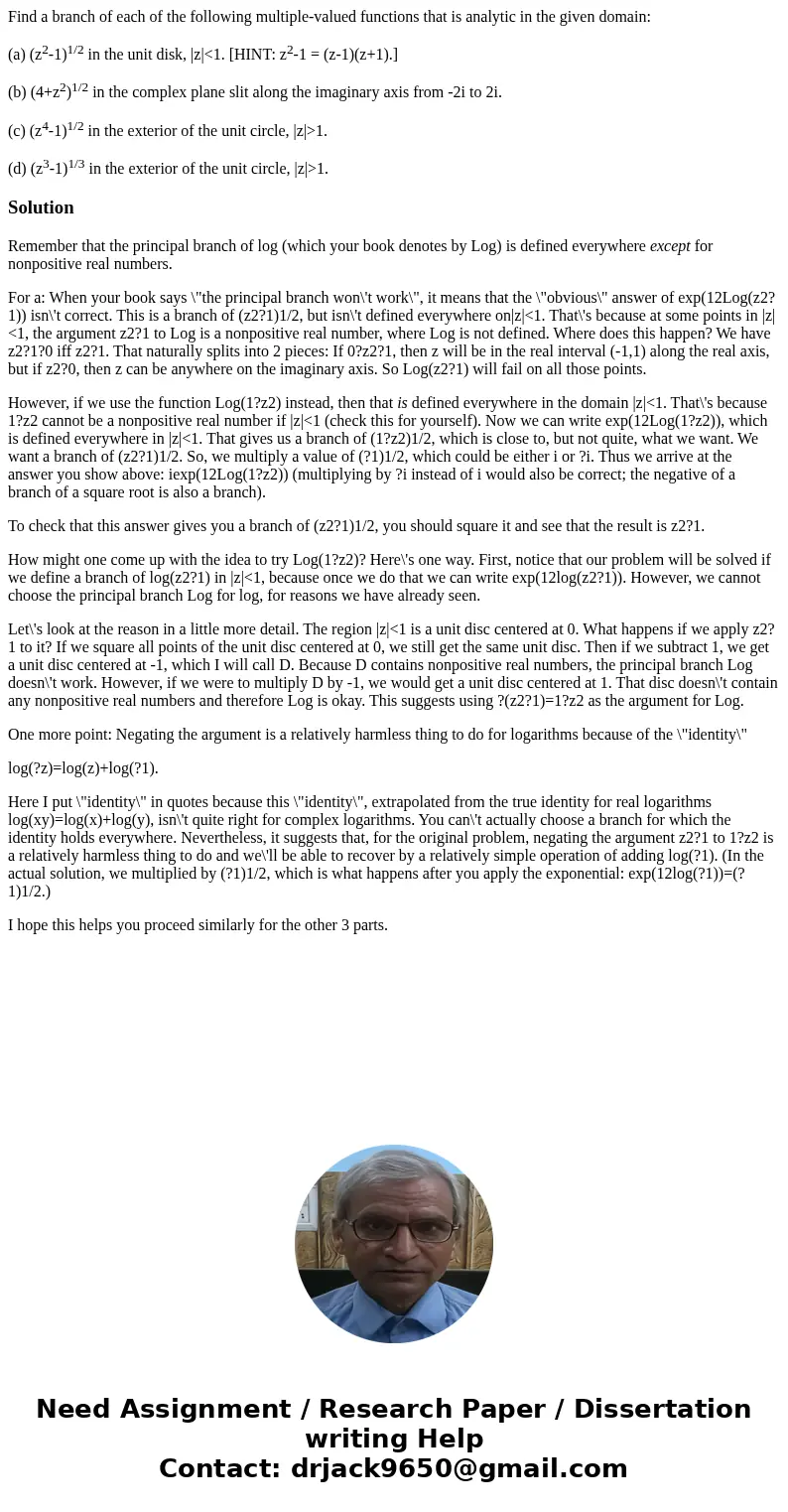Find a branch of each of the following multiplevalued functi
Find a branch of each of the following multiple-valued functions that is analytic in the given domain:
(a) (z2-1)1/2 in the unit disk, |z|<1. [HINT: z2-1 = (z-1)(z+1).]
(b) (4+z2)1/2 in the complex plane slit along the imaginary axis from -2i to 2i.
(c) (z4-1)1/2 in the exterior of the unit circle, |z|>1.
(d) (z3-1)1/3 in the exterior of the unit circle, |z|>1.
Solution
Remember that the principal branch of log (which your book denotes by Log) is defined everywhere except for nonpositive real numbers.
For a: When your book says \"the principal branch won\'t work\", it means that the \"obvious\" answer of exp(12Log(z2?1)) isn\'t correct. This is a branch of (z2?1)1/2, but isn\'t defined everywhere on|z|<1. That\'s because at some points in |z|<1, the argument z2?1 to Log is a nonpositive real number, where Log is not defined. Where does this happen? We have z2?1?0 iff z2?1. That naturally splits into 2 pieces: If 0?z2?1, then z will be in the real interval (-1,1) along the real axis, but if z2?0, then z can be anywhere on the imaginary axis. So Log(z2?1) will fail on all those points.
However, if we use the function Log(1?z2) instead, then that is defined everywhere in the domain |z|<1. That\'s because 1?z2 cannot be a nonpositive real number if |z|<1 (check this for yourself). Now we can write exp(12Log(1?z2)), which is defined everywhere in |z|<1. That gives us a branch of (1?z2)1/2, which is close to, but not quite, what we want. We want a branch of (z2?1)1/2. So, we multiply a value of (?1)1/2, which could be either i or ?i. Thus we arrive at the answer you show above: iexp(12Log(1?z2)) (multiplying by ?i instead of i would also be correct; the negative of a branch of a square root is also a branch).
To check that this answer gives you a branch of (z2?1)1/2, you should square it and see that the result is z2?1.
How might one come up with the idea to try Log(1?z2)? Here\'s one way. First, notice that our problem will be solved if we define a branch of log(z2?1) in |z|<1, because once we do that we can write exp(12log(z2?1)). However, we cannot choose the principal branch Log for log, for reasons we have already seen.
Let\'s look at the reason in a little more detail. The region |z|<1 is a unit disc centered at 0. What happens if we apply z2?1 to it? If we square all points of the unit disc centered at 0, we still get the same unit disc. Then if we subtract 1, we get a unit disc centered at -1, which I will call D. Because D contains nonpositive real numbers, the principal branch Log doesn\'t work. However, if we were to multiply D by -1, we would get a unit disc centered at 1. That disc doesn\'t contain any nonpositive real numbers and therefore Log is okay. This suggests using ?(z2?1)=1?z2 as the argument for Log.
One more point: Negating the argument is a relatively harmless thing to do for logarithms because of the \"identity\"
log(?z)=log(z)+log(?1).
Here I put \"identity\" in quotes because this \"identity\", extrapolated from the true identity for real logarithms log(xy)=log(x)+log(y), isn\'t quite right for complex logarithms. You can\'t actually choose a branch for which the identity holds everywhere. Nevertheless, it suggests that, for the original problem, negating the argument z2?1 to 1?z2 is a relatively harmless thing to do and we\'ll be able to recover by a relatively simple operation of adding log(?1). (In the actual solution, we multiplied by (?1)1/2, which is what happens after you apply the exponential: exp(12log(?1))=(?1)1/2.)
I hope this helps you proceed similarly for the other 3 parts.

 Homework Sourse
Homework Sourse